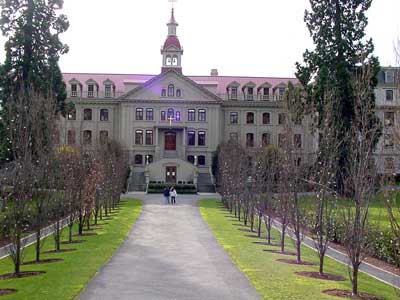Heritage Register
Fairfield
835 Humboldt Street
St Ann's Academy
Built
1858; 1871; 1886; 1909-10
Heritage-Designated/Institutional
Provincial Historic Site 1998
National Historic Site 1989
For: Sisters of St. Ann
Architects: Brother Joseph Michaud; Charles Vereydhen; John Teague; Thomas Hooper

ARCHITECTURE:
After the Legislature, the Empress Hotel and Craigdarroch Castle, St Ann’s Academy is one of the foremost landmarks of Victoria. Although built over some years, the overall effect is harmonious because of the architecture’s Classical vocabulary and the continuous dentil cornice. Balance is reinforced by the pair of tall sequoiadendron trees on each side of the main block and by the formal landscaping. The major stages of construction (1871 - 1910) are fairly obvious, but the buildings offer a rich visual treat for those prepared to look at the details. The 1871-86 main block, consisting of a pedimented central bay with a wing on each side, has a strong Québécois flavour reminiscent of the Eastern convents of the order of St. Ann. Note the steeply-pitched dormered roofs and the low relief pilasters below. The grand formality of the Baroque style is reflected in the divided staircase of the entrance pavilion and the balance and rhythm of the whole. The front boundary has a high brick wall with glazed terracotta capping and imposing iron gates under an arched iron entrance.
ORIGINAL OCCUPANTS:
The first Catholic archbishop of Vancouver Island, Bishop Modeste Demers, had a huge area as his responsibility, stretching at that time from the Strait of Juan de Fuca to the Arctic. He urgently needed teachers and quickly requested help from Quebec. Thus it was that four sisters from the order of St. Ann arrived in June 1858, having travelled by ship via the isthmus of Panama.
One of them, Sister Mary Angèle, wrote of her delight in the beauty of the area but also of her surprise at finding the community to be a “sea of tents.” The sisters moved into a log cabin that Jacques Laquechier built c.1844, Leon Morrell bought from the HBC in 1853, and the Bishop acquired in 1855. They wasted no time in opening a school in one of the cabin’s two rooms. This small building remained on the site for many years although the sisters soon found better quarters. It now stands beside Helmcken House (637 Elliot St, James Bay).
At that time the site faced a stream flowing through the Humboldt Valley into the James Bay tidal flats, before the area was drained and reclaimed. The sisters were nurses as well as teachers, and until St. Joseph’s Hospital opened in 1876, they cared for the sick in various locations around the growing city.
Construction of the academy began in 1871, designed by architect Charles Vereydhen. The 4-storey masonry building was the first of its kind in Victoria. This first building of the complex is now centred between the 1886 main entrance pavilion and east wing designed by John Teague, and the 1909-10 west wing by Thomas Hooper.
The chapel was designed by Br. Joseph Michaud in 1858 as the first St. Andrew’s Cathedral. This wooden building was brought in 1886 to the academy site on skids, incorporated into the back of the entrance pavilion and covered in masonry to blend into the new structure.
Over its 117 years’ history as an educational institution the academy taught over 36,000 students, making a huge contribution to education in the province. As well as a school and convent, the academy was also the administrative headquarters for the sisters’ nursing and missionary work throughout the province, the Yukon and Alaska.
OTHER OCCUPANTS:
By the early 1970s, declining enrolment and rising maintenance costs forced the Sisters of St. Ann to close the school and convent. It was purchased by the province in 1973, and they used it for offices for some years.
In the mid-1980s a developer proposed to convert the buildings and grounds to an amusement park and mall. Eventually the government gutted all but the chapel, the main entrance hallway, front parlours, and the auditorium, which were restored to how they had looked in the 1920s. Restoration and seismic upgrading of the interior were done in the 1990s by Paul Merrick Architects. The project, costing $16.7 million, was a long and difficult one. The exterior was not altered, just repaired and repainted in original colours. The gardens and landscaping were also somewhat restored before the site opened to the public as a National Historic Site in 1997. The Hallmark Society gave their President’s Award to the Provincial Capital Commission and BC Buildings Corp for the restoration in 1998. In 2000 Stuart Stark and Robert Patterson also won an award from the Hallmark Society for their restoration of the chapel.
St Ann’s now houses government offices, with the auditorium and chapel available for weddings, lectures and other functions. The grounds are open year round and several rooms including the chapel are open several hours a day. The peaceful novitiate garden at the southeast corner is a favourite place for a visit or a small reception. The novice nuns grew plants that represented the vows they would take - basil, veronica and sunflowers to represent poverty, chastity and obedience.
ADDITIONAL INFORMATION & IMAGES:
• Statement of Significance (Canadian Register of Historic Places)
• GIS Map of Victoria's Heritage Register Properties
• Fairfield History
• Fairfield Heritage Register
• Royal BC Museum Archives Image 1
• Royal BC Museum Archives Image 2
• Royal BC Museum Archives Image 3
• Royal BC Museum Archives Image 4
• This Old House, Victoria's Heritage Neighbourhoods,
Volume Four: Fairfield, Gonzales & Jubilee

